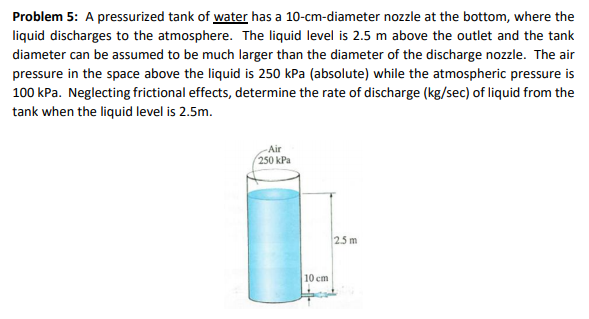Problem 5: A pressurized tank of water has a 10-cm-diameter nozzle at the bottom, where the liquid discharges to the atmosphere. The liquid level is 2.5 m above the outlet and the tank diameter can be assumed to be much larger than the diameter of the discharge nozzle. The air pressure in the space above the liquid is 250 kPa (absolute) while the atmospheric pressure is 100 kPa. Neglecting frictional effects, determine the rate of discharge (kg/sec) of liquid from the tank when the liquid level is 2.5m. Air 250 kPa 25 m 10 cm
Problem 5: A pressurized tank of water has a 10-cm-diameter nozzle at the bottom, where the liquid discharges to the atmosphere. The liquid level is 2.5 m above the outlet and the tank diameter can be assumed to be much larger than the diameter of the discharge nozzle. The air pressure in the space above the liquid is 250 kPa (absolute) while the atmospheric pressure is 100 kPa. Neglecting frictional effects, determine the rate of discharge (kg/sec) of liquid from the tank when the liquid level is 2.5m. Air 250 kPa 25 m 10 cm
Elements Of Electromagnetics
7th Edition
ISBN:9780190698614
Author:Sadiku, Matthew N. O.
Publisher:Sadiku, Matthew N. O.
ChapterMA: Math Assessment
Section: Chapter Questions
Problem 1.1MA
Related questions
Question
What forms of conservation laws apply to this
problem? (Write out as well as you can)
a. Conservation of Energy:
b. Conservation of Mass:

Transcribed Image Text:Problem 5: A pressurized tank of water has a 10-cm-diameter nozzle at the bottom, where the
liquid discharges to the atmosphere. The liquid level is 2.5 m above the outlet and the tank
diameter can be assumed to be much larger than the diameter of the discharge nozzle. The air
pressure in the space above the liquid is 250 kPa (absolute) while the atmospheric pressure is
100 kPa. Neglecting frictional effects, determine the rate of discharge (kg/sec) of liquid from the
tank when the liquid level is 2.5m.
Air
250 kPa
25 m
10 cm
Expert Solution
This question has been solved!
Explore an expertly crafted, step-by-step solution for a thorough understanding of key concepts.
This is a popular solution!
Trending now
This is a popular solution!
Step by step
Solved in 5 steps with 4 images

Knowledge Booster
Learn more about
Need a deep-dive on the concept behind this application? Look no further. Learn more about this topic, mechanical-engineering and related others by exploring similar questions and additional content below.Recommended textbooks for you

Elements Of Electromagnetics
Mechanical Engineering
ISBN:
9780190698614
Author:
Sadiku, Matthew N. O.
Publisher:
Oxford University Press

Mechanics of Materials (10th Edition)
Mechanical Engineering
ISBN:
9780134319650
Author:
Russell C. Hibbeler
Publisher:
PEARSON

Thermodynamics: An Engineering Approach
Mechanical Engineering
ISBN:
9781259822674
Author:
Yunus A. Cengel Dr., Michael A. Boles
Publisher:
McGraw-Hill Education

Elements Of Electromagnetics
Mechanical Engineering
ISBN:
9780190698614
Author:
Sadiku, Matthew N. O.
Publisher:
Oxford University Press

Mechanics of Materials (10th Edition)
Mechanical Engineering
ISBN:
9780134319650
Author:
Russell C. Hibbeler
Publisher:
PEARSON

Thermodynamics: An Engineering Approach
Mechanical Engineering
ISBN:
9781259822674
Author:
Yunus A. Cengel Dr., Michael A. Boles
Publisher:
McGraw-Hill Education

Control Systems Engineering
Mechanical Engineering
ISBN:
9781118170519
Author:
Norman S. Nise
Publisher:
WILEY

Mechanics of Materials (MindTap Course List)
Mechanical Engineering
ISBN:
9781337093347
Author:
Barry J. Goodno, James M. Gere
Publisher:
Cengage Learning

Engineering Mechanics: Statics
Mechanical Engineering
ISBN:
9781118807330
Author:
James L. Meriam, L. G. Kraige, J. N. Bolton
Publisher:
WILEY